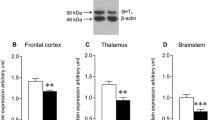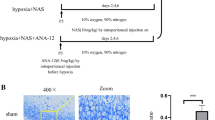Abstract
Neonatal hypoxia induces brain injury through alterations in neurotransmitters and its receptors. Molecular processes regulating serotonergic receptors play an important role in the control of respiration under hypoxia. The present study evaluates the serotonergic regulation of neonatal hypoxia and its resuscitation methods. Receptor binding assays and gene expression studies were done to evaluate the changes in 5HT2A receptors and its transporter in the cerebral cortex of hypoxic neonatal rats and hypoxic rats resuscitated with glucose, oxygen, and epinephrine. Hypoxic stress increased total 5HT and 5HT2A receptor number along with an upregulation of 5HT2A receptor and 5HT transporter gene in the cortex. The enhanced cortical 5HT2A receptors may act as a modulator of ventilatory response to hypoxia. These alterations were reversed to near control by glucose supplementation. Glucose supplementation helped in managing the serotonergic functional alterations. Hypoxia-induced adenosine triphosphate depletion causes a reduction in blood glucose levels which can be encountered by glucose administration, and oxygenation helps in overcoming the anaerobic condition. The adverse effect of immediate oxygenation and epinephrine supplementation was also reported. This has immense clinical significance in establishing a proper resuscitation for the management of neonatal hypoxia.




Similar content being viewed by others
References
Anju TR, Athira B, Paulose CS (2009) Superoxide dismutase functional regulation in neonatal hypoxia: effect of glucose, oxygen and epinephrine. Indian J Biochem Biophys 46:166–171
Baron AD, Wallace P, Brechtel G (1987) In vivo regulation of non-insulin-mediated and insulin-mediated glucose uptake by cortisol. Diabetes 36:1230–1237
Bennett-Clarke CA, Leslie MJ, Lane RD, Rhoades RW (1994) Effect of serotonin depletion on vibrissa-related patterns of thalamic afferents in the rat’s somatosensory cortex. J Neurosci 14:7594–7607
Bianchi AL, Denavit-Saubie M, Champagnat J (1995) Central control of breathing in mammals: neuronal circuitry, membrane properties, and neurotransmitters. Physiol Rev 75(1):1–45
Binoy J, Nandhu MS, Paulose CS (2009) Dopamine D(1) and D(2) receptor functional down regulation in the cerebellum of hypoxic neonatal rats: neuroprotective role of glucose and oxygen, epinephrine resuscitation. Pharmacol Res doi:. doi:10.1016/j.phrs.2009.08.007
Bonhan AC (1995) Neurotransmitters in the CNS control of breathing. Respir Physiol 101:219–230
Borella A, Bindra M, Whitaker-Azmitia PM (1997) Role of the 5-HT1A receptor in development of the neonatal rat brain: preliminary behavioral studies. Neuropharmacology 36:445–450
Choi DW (1988) Glutamate neurotoxicity and diseases of the nervous system. Neuron 1623–1634
Coyle JT, Puttfarcken P (1993) Oxidative stress, glutamate, and neurodegenerative disorders. Science 262:689–695
Dash R, Lawrence M, Sapolsky R (1996) A herpes simplex virus vector overexpressing the glucose transporter gene protects the rat dentate gyrus from an antimetabolite toxin. Exp Neurol 137:43–48
Davis JN, Carlsson A (1973) Effect of hypoxia on tyrosine and tryptophan hydroxylation in unanaesthetized rat brain. J Neurochem 20:913–915
Edagawa Y, Saito H, Abe K (2001) Endogenous serotonin contributes to a developmental decrease in long-term potentiation in the rat visual cortex. J Neurosci 21:1532–1537
Gargaglioni LH, Steiner AA, Branco LGS (2005) Involvement of serotoninergic receptors in the anteroventral preoptic region on hypoxia-induced hypothermia. Brain Res 1044:16–24
Glowinski J, Iversen LL (1966) Regional studies of catecholamines in the rat brain: the disposition of [3H] norepinephrine, [3H] DOPA in various regions of the brain. J Neurochem 13:655–669
Hattori H, Wasterlain CG (2004) Posthypoxic glucose supplement reduces hypoxicischemic brain damage in the neonatal rat. Ann Neurol 28:122–128
Ho DY, Saydam TC, Fink SL, Lawrence MS, Sapolsky RM (1995) Defective herpes simplex virus vectors expressing the rat brain glucose transporter protect cultured neurons from necrotic insults. J Neurochem 65:842–850
Ikeda Y, Anderson JH, Long DM (1989) Oxygen free radicals in the genesis of traumatic and peritumoral brain edema. Neurosurgery 24:679
Jayanthi LD, Ramamoorthy S, Mahesh VB, Leibach FH, Ganapathy V (1994) Calmodulin-dependent regulation of the catalytic function of the human serotonin transporter in placental choriocarcinoma cells. J Biol Chem 269:14424–14429
Jensen A, Künzel W, Kastendieck E (2009) Epinephrine and norepinephrine release in the fetus after repeated hypoxia. J Perinatal Med 10:109–110
Karacaoglu E, Bayram I, Celiköz B, Zienowicz RJ (2007) Does sustained epinephrine release trigger a hypoxia-neovascularization cascade? Plast Reconstr Surg 119:858–864
Kojic L, Gu Q, Douglas RM, Cynader MS (1997) Serotonin facilitates synaptic plasticity in kitten visual cortex: an in vitro study. Dev Brain Res 101:299–304
Kubin L, Tojima H, Davies RO, Pack AI (1992) Serotonergic excitatory drive to hypoglossal motoneurons in the decerebrate cat. Neurosci Lett 139:243–248
Launay JM, Bondoux D, Oset-Gasque MJ, Emami S, Mutel V, Haimart M, Gespach C (1994) Increase of human platelet serotonin uptake by atypical histamine receptors. Am J Physiol 266:R526–R536
Lawrence MS, Sun GH, Kunis DM, Saydam TC, Dash R, Sapolsky Ho DY, RM SGK (1996) Overexpression of the glucose transporter gene with a herpes simplex viral vector protects striatal neurons against stroke. J Cereb Blood Flow Metab 16:181–185
Leysen JE, Neimegeers CJE, Van Nueten JM, Laduron PM (1982) [3H] Ketanserin, a selective ligand for serotonin2 receptor binding sites. Mol Pharmacol 21:301–314
Li Y, Powers C, Jiang N, Chopp M (1998) Intact, injured, necrotic, and apoptotic cells after focal cerebral ischemia in the rat. J Neurol Sci 156:119–132
Lindsay AD, Feldman JL (1993) Modulation of respiratory activity of neonatal rat phrenic motoneurones by serotonin. J Physiol Lond 461:213–233
Lindstrom K, Lagerroos P, Gillberg C, Fernell E (2006) Teenage outcome after being born at term with moderate neonatal encephalopathy. Pediatr Neurol 35:268–274
Lowry OH, Rosenbrough NJ, Farr AL, Randall RJ (1951) Protein measurement with folin phenol reagent. J Biol Chem 193:265–275
Mazer C, Muneyyirci J, Taheny K, Raio N, Borella A, Whitaker-Azmitia P (1997) Serotonin depletion during synaptogenesis leads to decreased synaptic density and learning deficits in the adult rat: a possible model of neurodevelopmental disorders with cognitive deficits. Brain Res 760:68–73
McAuliffe JJ, Miles L, Vorhees CV (2006) Adult neurological function following neonatal hypoxia–ischemia in a mouse model of the term neonate: water maze performance is dependent on separable cognitive and motor components. Brain Res 1118:208–221
McGuire M, Zhang Y, White DP, Ling L (2004) Serotonin receptor subtypes required for ventilatory long-term facilitation and its enhancement after chronic intermittent hypoxia in awake rats. Am J Physiol 286:R334–R341
Mercuri E, Ricci D, Cowan FM, Lessing D, Frisone MF, Haataja L, Counsell SJ, Dubowitz LM, Rutherford MA (2000) Head growth in infants with hypoxic–ischemic encephalopathy: correlation with neonatal magnetic resonance imaging. Pediatrics 106:235–243
Miller KJ, Hoffman BJ (1994) Adenosine A3 receptors regulate serotonin transport via nitric oxide and cGMP. J Biol Chem 269:27351–27356
Neubauer JA, Melton JE, Edelman NH (1990) Modulation of respiration during brain hypoxia. J Appl Physiol 68:441–451
Olson EB Jr, Vidruk EH, McCrimmon DR, Dempsey JA (1983) Monoamine neurotransmitter metabolism during acclimatization to hypoxia in rats. Respir Physiol 54:79–96
Paulose CS, Finla C, Reas Khan S, Amee K (2007) Neuroprotective role of Bacopa monnieri extract in epilepsy and effect of glucose supplementation during hypoxia:glutamate receptor gene expression. Neurochem Res 33:1663–1671
Poncet L, Denoroy L, Dalmaz Y, Pequignot JM (1997) Activity of tryptophan hydroxylase and content of indolamines in discrete brain regions after a long-term hypoxic exposure in the rat. Brain Res 765:122–128
Rhoades RW, Bennett-Clarke CA, Shi M-Y, Mooney RD (1994) Effects of 5-HT on thalamocortical synaptic transmission in the developing rat. J Neurophysiol 72:2438–2450
Richter DW, Schmidt-Garcon P, Pierrefiche O, Bischoff AM, Lalley PM (1999) Neurotransmitters and neuromodulators controlling the hypoxic respiratory response in anaesthetized cats. J Physiol 514:567–578
Richter DW, Manzke T, Wilken B, Ponimaskin E (2003) Serotonin receptors: guardians of stable breathing. Trends Mol Med 9(12):542–548
Rigatto H, Wiebe C, Rigatto C, Lee DS, Cates D (1988) Ventilatory response to hypoxia in unanesthetized newborn kittens. J Appl Physiol 64:2544–2551
Sakamoto A, Ohnishi ST, Ohnishi T, Ogawa R (1991) Relationship between free radical production and lipid peroxidation during ischemia-reperfusion injury in the rat brain. Brain Res 554:186
Scatchard G (1949) The attractions of proteins for small molecules and ions. Ann N Y Acad Sci 51:660–672
Shalak L, Perlman JM (2004) Hypoxic–ischemic brain injury in the term infant—current concepts. Early Hum Dev 80(2):125–141
Sheldon RA, Sedik C, Ferriero DM (1998) Strain-related brain injury in neonatal mice subjected to hypoxia–ischemia. Brain Res 810:114–122
St. John WM (1981) Respiratory neuron responses to hypercapnia and carotid chemoreceptor stimulation. J Appl Physiol 51:816–822
Steiner AA, Branco LGS (2003) Fever and anapyrexia in systemic inflammation: intracellular signaling by cyclic nucleotides. Front Biosci 8:1398–1408
Uzbekov MN, Murphy S, Rose SPR (1979) Ontogenesis of serotonin ‘receptors’ in different regions of rat brain. Brain Res 168:195–199
van Handel M, Swaab H, de Vries LS, Jongmans MJ (2007) Long-term cognitive and behavioral consequences of neonatal encephalopathy following perinatal asphyxia: a review. Eur J Pediatr 166:645–654
Vannucci SJ, Hagberg H (2004) Hypoxia–ischemia in the immature brain. J Exp Biol 207:3154–3749
Wrona MZ, Dryhurst G (1991) Interactions of 5-hydroxytryptamine with oxidative enzymes. Biochem Pharmacol 41:1145
Yura A, Kiuchi Y, Uchikawa T, Uchida J, Yamazaki K, Oguchi K (1996) Possible involvement of calmodulin-dependent kinases in Ca2+-dependent enhancement of [3H] 5-hydroxytryptamine uptake in rat cortex. Brain Res 738:96–102
Acknowledgments
This work was supported by the research grants from DBT, DST, ICMR, government of India and KSCSTE, government of Kerala to Dr. C. S. Paulose. T.R. Anju thanks the Council of Scientific and Industrial Research for the Senior Research Fellowship.
Author information
Authors and Affiliations
Corresponding author
Rights and permissions
About this article
Cite this article
Anju, T.R., Smijin, S., Korah, P.K. et al. Cortical 5HT2A Receptor Function under Hypoxia in Neonatal Rats: Role of Glucose, Oxygen, and Epinephrine Resuscitation. J Mol Neurosci 43, 350–357 (2011). https://doi.org/10.1007/s12031-010-9449-3
Received:
Accepted:
Published:
Issue Date:
DOI: https://doi.org/10.1007/s12031-010-9449-3




